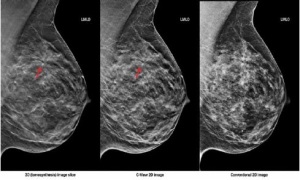by
Carol Ko, Staff Writer | July 19, 2013

Hologic's C-View 2D imaging software
From the July 2013 issue of HealthCare Business News magazine
It’s no secret that getting a mammogram is a nerve-wracking experience for many women. Although some studies suggest women at higher risk for breast cancer are more likely to get regular screens, others show that the most fearful women are the least likely to be screened.
To that end, many imaging centers are working to try to put women at ease by making their mammography screening more than just a test. “We want to make sure they’re the most important person at that given moment,” explains Barbara Marshall of Battlefield Imaging.
The facility, based in Ringgold Georgia, is designed to convey a spa-like feeling, complete with oversized furniture, flat screen TVs and a nutrition café. Even the center’s mammography machines supplied by Siemens contribute to the atmosphere, coming in different colors like pink and green, and equipped with mood lighting designed to soothe the patient. “It’s been the talk of the community,” says Marshall. “The patients are surprised when they see it, they say, this is beautiful.”



Ad Statistics
Times Displayed: 797
Times Visited: 5 Keep biomedical devices ready to go, so care teams can be ready to care for patients. GE HealthCare’s ReadySee™ helps overcome frustrations due to lack of network and device visibility, manual troubleshooting, and downtime.
But even as doctors are trying to encourage more of the population to get screened regularly, others are questioning whether routine annual screenings for certain women are necessary at all.
The great mammography debate
A series of controversial recommendations and studies that question the benefits of mammography screening have spurred heated debate in breast imaging. Many physicians now think that traditional 2-D mammography screening as it was developed in the 1970s needs a major overhaul, while others vehemently disagree.
While the benefits of mammography have been contested in one form or another for 30 years, the controversy heated up when United States Preventive Services Task Force, a government-appointed group of 16 nationally recognized experts, released its findings on mammography screening in 2009.
Its recommendations, which were in conflict with recommendations from the American Cancer Society and other medical groups, questioned the need for annual screenings. They found that most women can wait till they’re 50 before getting regular mammograms, and that women between the ages of 50-74 who do get them should have screenings every other year, not annually. Their conclusions were drawn from evidence that showed every-other-year screenings would still detect over 80 percent of the cancers found in annual screening while cutting the number of false positives by nearly half.
But these recommendations aren’t a fluke: The American College of Physicians made similar recommendations two years ago and the National Breast Cancer Coalition, an advocacy group for patients, has openly expressed skepticism around mammography’s limitations and urges women to make their own decisions based on the best available facts.

